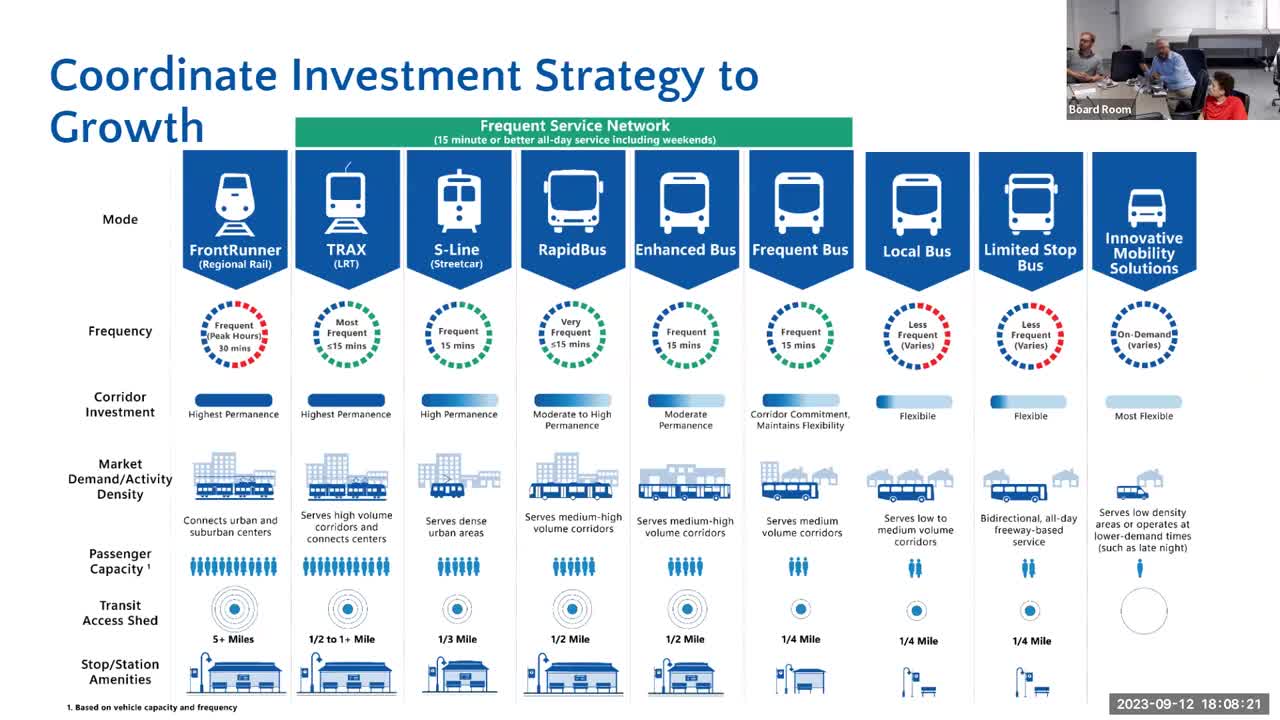Transit Authority Plans Major Overhaul to Boost Regional Connectivity
September 13, 2023 | Wasatch Choice Community Advisory Committee, Wasatch Front Regional Council, Wasatch County Commission and Boards, Wasatch County, Utah
This article was created by AI summarizing key points discussed. AI makes mistakes, so for full details and context, please refer to the video of the full meeting. Please report any errors so we can fix them. Report an error »

In a recent government meeting, officials discussed a comprehensive plan to enhance public transportation across Utah, addressing the growing demand for mobility solutions in the rapidly expanding region. The meeting highlighted a range of initiatives aimed at improving service frequency, expanding routes, and integrating innovative mobility options.
Key proposals include the expansion of community rail, regional rail services, and light rail, alongside enhanced bus services. Officials emphasized the importance of \"innovative mobility solutions,\" which may involve partnerships with ride-sharing companies like Lyft and Uber, as well as the introduction of ride vouchers to facilitate on-demand transportation.
The Utah Transit Authority (UTA) is focusing on maintaining and improving the existing transit system, with plans to increase service availability during weekends and extend operational hours. This shift aims to adapt to changing commuting patterns, moving away from the traditional nine-to-five model.
Specific improvements are planned across various counties, including Box Elder, Davis, Weber, Salt Lake, and Utah County. The UTA's strategic goals include enhancing access to transit, increasing ridership, and improving air quality, all while ensuring that the system remains sustainable and efficient.
Officials also mentioned ongoing outreach efforts to gather community feedback through open houses and online surveys, emphasizing the importance of public input in shaping future transit plans. However, they noted that the current vision for transit improvements is \"fiscally unconstrained,\" indicating that not all proposed projects will be realized by 2050.
The meeting concluded with discussions on new service types, including bi-directional all-day service aimed at improving regional connectivity. This service is expected to operate with frequencies similar to rail systems, potentially paving the way for future infrastructure investments.
As Utah continues to grow, these initiatives reflect a proactive approach to meet the evolving transportation needs of its residents.
Key proposals include the expansion of community rail, regional rail services, and light rail, alongside enhanced bus services. Officials emphasized the importance of \"innovative mobility solutions,\" which may involve partnerships with ride-sharing companies like Lyft and Uber, as well as the introduction of ride vouchers to facilitate on-demand transportation.
The Utah Transit Authority (UTA) is focusing on maintaining and improving the existing transit system, with plans to increase service availability during weekends and extend operational hours. This shift aims to adapt to changing commuting patterns, moving away from the traditional nine-to-five model.
Specific improvements are planned across various counties, including Box Elder, Davis, Weber, Salt Lake, and Utah County. The UTA's strategic goals include enhancing access to transit, increasing ridership, and improving air quality, all while ensuring that the system remains sustainable and efficient.
Officials also mentioned ongoing outreach efforts to gather community feedback through open houses and online surveys, emphasizing the importance of public input in shaping future transit plans. However, they noted that the current vision for transit improvements is \"fiscally unconstrained,\" indicating that not all proposed projects will be realized by 2050.
The meeting concluded with discussions on new service types, including bi-directional all-day service aimed at improving regional connectivity. This service is expected to operate with frequencies similar to rail systems, potentially paving the way for future infrastructure investments.
As Utah continues to grow, these initiatives reflect a proactive approach to meet the evolving transportation needs of its residents.
Don't Miss a Word: See the Full Meeting!
Go beyond summaries. Unlock every video, transcript, and key insight with a Founder Membership.
✓
Get instant access to full meeting videos
✓
Search and clip any phrase from complete transcripts
✓
Receive AI-powered summaries & custom alerts
✓
Enjoy lifetime, unrestricted access to government data
30-day money-back guarantee


